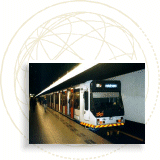| Tokyo - TRTA & TBTMG
Crime prevention measures
 The extremely low crime rates within the Tokyo metro system are,
first of all, the result of the low incidence of crime in the
Japanese society. In other words, the criminal pressure upon the
metro system is low. Beside this, there are some internal factors
that contribute to this low-crime situation. The level of informal
and semi-formal control within the Tokyo metro is high and ever-present.
At every hour of the day, travellers and staff are present in
every part of the metro system. Both the passengers and metro
staff are motivated both in the performance of control as in exercising
corrective behaviour in cases of criminal occurrence. This high
level of responsibility is stimulated by a metro design and management
that keeps the people involved. Every station has a station manager
who is responsible for the atmosphere and efficiency of "his"
station. The stations and trains are kept clean, neat, and well-maintained.
A clear norm is set and maintained both by station design, organisational
measures, and the cooperation of the travellers. Smoking and littering
are forbidden and fare evasion is prevented by the system-wide
installation of automated ticket vending and collecting machines,
formal gate control, and machines for the payment of access fares.
The extremely low crime rates within the Tokyo metro system are,
first of all, the result of the low incidence of crime in the
Japanese society. In other words, the criminal pressure upon the
metro system is low. Beside this, there are some internal factors
that contribute to this low-crime situation. The level of informal
and semi-formal control within the Tokyo metro is high and ever-present.
At every hour of the day, travellers and staff are present in
every part of the metro system. Both the passengers and metro
staff are motivated both in the performance of control as in exercising
corrective behaviour in cases of criminal occurrence. This high
level of responsibility is stimulated by a metro design and management
that keeps the people involved. Every station has a station manager
who is responsible for the atmosphere and efficiency of "his"
station. The stations and trains are kept clean, neat, and well-maintained.
A clear norm is set and maintained both by station design, organisational
measures, and the cooperation of the travellers. Smoking and littering
are forbidden and fare evasion is prevented by the system-wide
installation of automated ticket vending and collecting machines,
formal gate control, and machines for the payment of access fares.
The fact that the crime prevention construction and management
of low-crime metro systems must be up-to-date and well-prepared
to expect the unexpected was clearly demonstrated in 1995 when
a member of a religious sect cowardly attacked the Tokyo metro
with several packages of Sarin gas. This single event instantly
transformed one of the safest metro systems in the world into
the scene of the most serious criminal case in metro history.
|
Source: López, M.J.J., Crime Prevention
Guidelines for the Construction & Management of Metro Systems,
Den Haag: RCM-advies 1996, pg. 23-25.
 Order
this book Order
this book
|

 The extremely low crime rates within the Tokyo metro system are,
first of all, the result of the low incidence of crime in the
Japanese society. In other words, the criminal pressure upon the
metro system is low. Beside this, there are some internal factors
that contribute to this low-crime situation. The level of informal
and semi-formal control within the Tokyo metro is high and ever-present.
At every hour of the day, travellers and staff are present in
every part of the metro system. Both the passengers and metro
staff are motivated both in the performance of control as in exercising
corrective behaviour in cases of criminal occurrence. This high
level of responsibility is stimulated by a metro design and management
that keeps the people involved. Every station has a station manager
who is responsible for the atmosphere and efficiency of "his"
station. The stations and trains are kept clean, neat, and well-maintained.
A clear norm is set and maintained both by station design, organisational
measures, and the cooperation of the travellers. Smoking and littering
are forbidden and fare evasion is prevented by the system-wide
installation of automated ticket vending and collecting machines,
formal gate control, and machines for the payment of access fares.
The extremely low crime rates within the Tokyo metro system are,
first of all, the result of the low incidence of crime in the
Japanese society. In other words, the criminal pressure upon the
metro system is low. Beside this, there are some internal factors
that contribute to this low-crime situation. The level of informal
and semi-formal control within the Tokyo metro is high and ever-present.
At every hour of the day, travellers and staff are present in
every part of the metro system. Both the passengers and metro
staff are motivated both in the performance of control as in exercising
corrective behaviour in cases of criminal occurrence. This high
level of responsibility is stimulated by a metro design and management
that keeps the people involved. Every station has a station manager
who is responsible for the atmosphere and efficiency of "his"
station. The stations and trains are kept clean, neat, and well-maintained.
A clear norm is set and maintained both by station design, organisational
measures, and the cooperation of the travellers. Smoking and littering
are forbidden and fare evasion is prevented by the system-wide
installation of automated ticket vending and collecting machines,
formal gate control, and machines for the payment of access fares. Order
this book
Order
this book